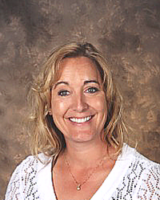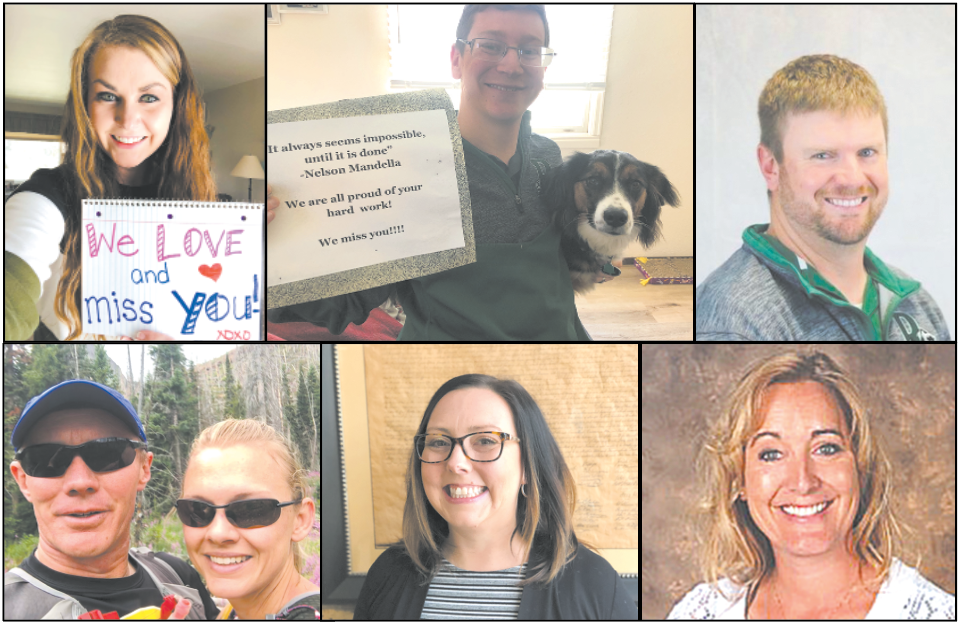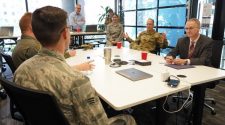RBC | Our schoolteachers have been assigned a Herculean task: learn an entirely new way of connecting with and teaching their students, and do it almost overnight. Both Rio Blanco County school districts have shifted to distance learning for students from kindergarten through high school. Students have been provided with Chromebooks, and teachers connect with their students online. The Herald Times reached out to a few teachers in Meeker and Rangely for their perspective now that they have a week or two of online instruction behind them.
***

COURTESY PHOTO
Danielle Dahl, 26, teaches kindergarten at Parkview Elementary in Rangely. She has been teaching for five years, and this is her third year as a kindergarten teacher.
“Now at home during my distance learning teaching experience, I have my husband, Adam, and one-year-old daughter, Addison, to help me to keep the learning going! My daughter loves to be in the morning video I do each day to greet my learners, and they have told me how much they enjoy seeing her, too,” Dahl said via email.
Dahl particularly misses interacting with her students in person. “A school day for us includes lots of conversations and hands-on learning. As a teacher, I would facilitate by roaming around, seeing/listening to my learners struggle through problems and get to light bulb moments, conferencing with them to guide them to new discoveries, and I was there to give a hug when it was needed.”
While there’s still interaction online, it’s not the same, and that adds to her concern for her students. “Is any of this going to be enough?”
Three lessons a day focused on math, reading, writing, art, and/or science, plus optional activities, has Dahl planning lessons, making videos, giving feedback and answering questions from families, while expecting “not more than an hour to an hour and a half of work a day” to help support families.
“It feels like we are doing everything we can, but you can’t help but wonder if it is enough to make our kids feel successful and help them to keep growing.”
Is there a silver lining? For Dahl it’s seeing the community come together to support the schools.
“When I reach out to families they are so positive and are doing everything they can to help their learner at home. They have been understanding of any hiccups that we have had, and have committed to this new way of learning, while many are still having to keep up with their own jobs. This experience has brought out the kind, understanding, and supportive side of Rangely that I have always known to be there, but greatly appreciate even more now. I am truly blessed to teach in such a great place!”
She’s also grateful to work for a district that has been “forward-thinking on technology.”
“Long before the pandemic, our IT director, administration, and school board worked very hard to make our district a place where almost all students have their own device, and all students use technology daily. Blake Mobley, our IT director, has worked wonders to support staff in knowing how to use technology, making sure we are creating a safe learning environment while using technology and has given more tips then we know what to do with to help support us on our devices. Things like Google and Seesaw were part of classrooms on a daily basis, and most students used these types of learning platforms every day. Therefore, when we had to switch to distance learning, we were much more prepared than other districts around the state to have a successful transfer to distance learning. There is no way that distance learning can take the place of being in a real classroom, but in times of crisis, I am grateful that we were able to equip families with the tools they need to continue our learning from home.”
***



COURTESY PHOTO
Matthew Hunter teaches fourth grade at Parkview Elementary and is in his seventh year of teaching. Hunter said making sure students understand the technology and expectations, making sure their social-emotional needs are met, and providing productive feedback for students on their answers have been some of the challenges to the switch to online learning.
Asked about his greatest concerns as a teacher, Hunter responded, “The greatest concern as a teacher is that the basic needs of all children are being met. Specifically, do they have enough food, enough sleep at night, and that they are safe. Those three things are outside of the school’s control and are almost always our concern even without distance learning.”
Becoming comfortable with technologies like Google Classroom, Google Meet and Google Hangout, and seeing students gain comfort with use of Chromebooks as a learning tool has been a silver lining.
Hunter said his concerns about students who don’t complete assignments or participate in class is the same, inside the classroom and with distance learning.
“I hope this time has provided teachers, parents, and students an opportunity to appreciate the day to day work that is completed in the classroom, as well as, opened the gateway to 21st-century teaching methods, to provide students the greatest opportunity to succeed.”
***



COURTESY PHOTO
Jeremy Lohry, 33, teaches social studies at Rangely High School. This is his eighth year teaching. Instead of being in the classroom, now he’s teaching from home with his wife Kristin, 1-½ year old son Fisher, dogs Tucker and Darla and Eva the cat.
With a full house, Lohry said his biggest challenge has been trying to stay in a normal routine. “Staying on a routine, I believe, is a healthy way to stay occupied and positive during these trying times and it’s one of the many messages I have been trying to send to my students.”
His greatest concern is the effectiveness of online communication. “…Will they understand the objectives of the assignment and have I clearly identified the learning goals of the assignment to the students?” He also worries that they have everything they need to succeed, and if they understand the assignments teachers are giving are purposeful, meaningful work.
There is a silver lining, Lohry shared. Online conversations have allowed him to get to know his students even better than before “The students are often inquisitive with me about what I have been doing during my ‘different’ time, as the students have labeled this unique situation.”
As a social studies teacher living through the first pandemic of the modern age, Lohry is looking ahead to ways to learn from the experience. “It may even create a new unit on responses to pandemics in the United States,” he said via email.
***



COURTESY PHOTO
Naomi Etchart, 38, has been teaching for 13 years. She’s a high school math instructor at Meeker High School, and with the switch to distance learning is now teaching classes with her two sons in the background.
“My biggest challenges in the switch to online teaching have been balancing time between teaching my students and helping my own children, and making sure that all of my students are able to access the digital material.”
The dramatic changes to teaching and learning demand balance, Etchart said via email. “My greatest concern right now is balance — making sure that I still have high expectations for my students while also giving them grace while we navigate our new normal.”
As a silver lining, like many who are staying home for work, Etchart is grateful for being able to spend more time with her family
***



COURTESY PHOTO
Heather Burke is in her 17th year teaching second grade at Meeker Elementary School.
Switching to online instruction has been a twofold challenge, Burke said via email: “An increase of my own knowledge of technology resources and seeking out how to implement them” and “greater communication with both students and parents to make sure everyone is able to both access the content and also feel supported with at-home learning.”
She’s concerned about maintaining a personal connection with families during this time. “This situation was not something students and families were planning on happening in our society, but here we are learning to do it and making it through.”
Her students, and the community, are her silver lining. “In light of it all, kids are resilient and rise above the chaos. They never quit smiling and they bring joy during a trying time for all. It has been fun seeing them with laptops under blanket tents, above them on the couch, or bringing a pet or sibling to a live meeting to join in the conversation. If nothing else, it has taught them more about adapting and making lemonade when life throws us lemons. Their willingness to try makes it sweet. Families have supported their children and been a part of holding them accountable for learning, even if it’s different. The community support has been amazing! Overall, this time has taught me that human interaction and communication are extremely important and that by coming together we can overcome adversity.”
***



COURTESY PHOTO
Kirstie Strate, 38. Has been teaching for 15 years. She currently teaches fifth grade at Meeker Elementary School. Her husband John is a teacher at Meeker High School.
Strate said, via email, her biggest challenge in the switch to online instructions has been “meeting kids where they are at and providing enough rigor to continue purposeful learning. I don’t want to overwhelm parents with lessons or expectations and to find a balance so that kids can do the work without putting additional stress on families.”
Like her fellow teachers, Strate is concerned about her students’ needs being met — food, counseling and instruction. “I worry about not providing the right instruction, too much instruction, too little. I’m concerned about kids who go ‘dark’ and you can’t seem to get a response from them academically or otherwise.”
Like many who are working from home, technology has provided Strate’s silver lining. “I still get to interact with my students, even though it’s through Google Slides or Hangouts or Flip Grid. It has encouraged students and teachers to learn new tech skills and share what they have learned. It has also given me the opportunity to connect and have more thought-provoking conversations with my family who, usually, are going every which way.”
Strate said she’s amazed at what our community can accomplish when they come together. “We have wonderful staff and community that help each other, everyone is doing their part and contributing in some way.”
By Niki Turner | [email protected]


















